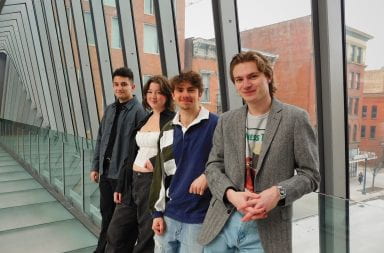
Olivia Coady selects the music channel to play in the Union Market from the music terminal in Woody’s. Credit: Paul B Ellis | For The Lantern
Plenty of Ohio State employees influence many students in the course of doing their jobs, but few influence students as early in the day as Olivia Coady.
Coady, a fourth-year in communication who is a Dining Services student manager at Espress-OH in the Ohio Union, gets to choose the music that plays in Espress-OH and the Union Market over the speaker system.
“In the morning, I immediately just rush back there and will turn on jazz music or some kind of alternative music — just a change of pace,” she said.
Alison Kabo, a third-year in the health sciences program who is a Dining Services student lead at Woody’s Tavern, noted a similar, though more competitive, process takes place when Woody’s opens at 11 a.m. on weekdays.
“Normally there’ll be two of us opening in the front of house, so I think everyone wants to choose their own music, so it’s whoever gets there first,” she said. “There’s other things to do, obviously, but someone will be like, ‘Oh, I’ll go pick the music and turn the TVs on.’ So then they’ll get to choose it.”
The mystery of who is behind the morning tunes wafting through OSU dining establishments can have a momentary captivating effect on the students who, lacking headphones, exercise no control over their pre-class playlist.
“You always get to choose what you do, obviously, when it comes to your music selection on your iPod,” said Coady, considering the impact of her music choice on the people with a spectrum of musical tastes who pass through the Union. “I feel like it’s how a lot of people discover music, by randomly being exposed to it. Like if you’re at a friend’s house and they put on a song, you’re like, ‘What song is that?’”
But while dining services employees have some choice of what music to play, the process isn’t entirely independent of an algorithm.
OSU’s Office of the Chief Information Officer has a contract with Mood Media, a professional background music company with subsidiaries such as Muzak, best known for providing elevator music in upscale buildings.
According to associate director of OCIO’s Marketing, Communication & Training Beth Varcho, the university signed a contract with Mood six years ago to provide “versatile” services to “a lot of different departments.” Varcho noted that the cost of the contract varies depending on how many departments use the service, but it costs on average roughly $100 per month for each department that wants to use Mood.
“We want the reception to be stable and high quality. We don’t want the equipment requirements to be too high, so that people have to invest in really expensive equipment. We want people to be able to use what they have,” Varcho said, detailing the university’s priorities in making the contract.
The departments that want to use music through the contract need a connection from the downlink by which the music is streamed to the hardware needed to play it, according to Dave Isaacs, spokesman for the Office of Student Life.
Mood provides a number of music channels, each focused on a genre or common theme like other popular streaming services such as Pandora, Spotify and Apple Music. But each day, it’s up to the student employees to pick which channel plays.
Kabo often makes her selection of channel for Woody’s by auditioning candidates, though she noted some of her coworkers have a more mischievous intent when they choose.
“We have two (channels) that we normally have playing, but I think we flip through and listen to what they have going,” she said.
Kabo added that employees’ choices of channels aren’t without feedback from coworkers and customers.
“We have certain people at Woody’s that will pick funny music just to see if someone will notice,” she said. “And it’ll be playing their entire shift, and then the new people will come in and be like, ‘Wow, who picked this music?’ Like, it’s mariachi music or elevator music, so that’s fun to do.”
Coady, who also works at local alternative radio station CD102.5, said her coworkers at Espress-OH can usually tell if she picked the channel.
“There is one girl, one of my friends here, who despises when I put on jazz just because she’s like, ‘You’re not an 80-year-old woman. You need to take it back a step,’” Coady said.
At Woody’s, Kabo has had a similar experience.
“I really like country music, but when I play it in Woody’s, I get yelled at ‘cause a lot of people don’t like country music,” she said.
Kabo has a go-to alternate channel, however.
“Normally, if it’s not country music that they let me play, I’ll do pop music just ‘cause that’s upbeat, fun,” she said. “Everyone knows it.”
The fact that everyone knows pop music is exactly why Coady said she feels the variety of music played in the Union can broaden people’s musical horizons.
“Usually at night, the market people will turn it on to pop music, and it just starts to get really tiring because not only are you hearing those songs here, but you’re hearing them on the radio, everywhere you look you’re hearing, like, One Direction,” she said. “At six o’clock in the morning, you’re just over it.”
Coady also drew parallels between choosing the music as part of her job in the Union and her experience at CD102.5.
“If you’re changing (the radio) channel, you’re just kind of randomly exposed to that genre, that artist, that song even,” she said. “I think that’s a great way that people explore music in general.”


